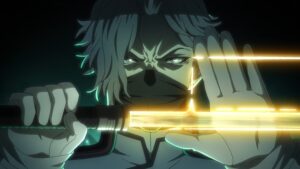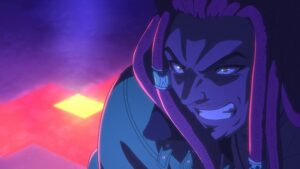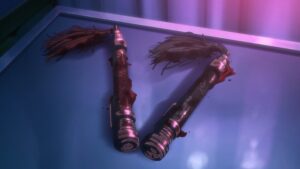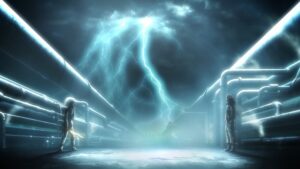All of Akudama Drive’s episodes are named after famous crime or action movies: Se7en, Reservoir Dogs, Dead Man Walking, etc. Each film title has some relation to the plot of its anime counterpart; for instance, “Mission Impossible” was the name used for the characters’ improbable boarding of the Shinkansen, while “Speed” refers to the episode where the same train hurtles toward oblivion (in that movie it was a bus, but the parallel sort of holds up). This week’s title is “Brother,” which is the first Japanese film to be featured, and it’s probably the weightiest parallel yet, thematically speaking. It should be noted that I haven’t seen Brother, but I did read a Wikipedia plot synopsis ten minutes before writing this post (very professional), so there will be spoilers for both that film and this episode of Akudama Drive after the jump.
Brother is a gangster film directed by Takeshi Kitano and centering on an enforcer named Yamamoto, who flees to Los Angeles after his Yakuza family is defeated. Drawing on his past experience, he quickly integrates himself into L.A.’s gang scene and becomes a major player in its underworld, eventually butting heads with the Italian Mafia. Thus, Brother pits two criminal organizations against each other, much as Akudama Drive does this week. You might think that the anime’s tale of insane delinquents versus the lawful Execution Department is comparatively straightforward, but this episode paints a more interesting picture than that. The boss of the Kansai Police claims that “Executioners barely differ from Akudama” in seeking out their own deaths, which is backed up by the Brawler vs. Executioner fight. The former character proclaims his love for violent combat with childlike glee, egging on his opponent to make the same admission. Executioner eventually admits that he’s enjoying himself – that at his core, he’s driven by the same destructive impulse as his many targets – which surely violates the spirit of the law he’s sworn to uphold.
Though Yamamoto is Brother’s central protagonist, it’s Brawler (a simpleminded secondary character) who stands in for Yamamoto in Akudama Drive. Both men are given the nickname “Aniki” in their respective stories, and while Brawler isn’t the leader of the Akudama, his overwhelming strength is primarily responsible for the advancement of their mission. That strength is on full display in this episode, which finally returned to the frenetically detailed standard of the first. Honestly, this one may have topped the premiere on the back of its inbetween work, which blew me away with its density of motion. One trend I noticed here was characters looking away from the camera, then turning to face it in buttery smooth fashion. Brawler did this twice, his initial opposition to the lens foreshadowing his imminent death, with the looks toward it serving as final expressions of his tremendous will. Of course, the rest of the episode looked great too, especially the multiple hand-to-hand fights, realistic rain effects, and duo-chromatic color scheme (see the screencaps at the start of the post).
I didn’t do enough reading to learn Yamamoto’s fate at the end of Brother, since I plan to watch it eventually and want to save at least a few surprises for myself. Brawler is definitively dead, however, as is the Kakashi-looking Executioner. Despite their lust for victory, both men perish in battle, and the aftermath is uncharacteristically somber. A lengthy, wordless scene is dedicated to Hoodlum and Kouhai’s discovery of their deceased comrades, but it isn’t silent – the rain falling around them is deafening. The presence of this unyielding elemental display put me in mind of another unrelenting force: revenge. After staring at his aniki’s corpse for a while, Hoodlum grabbed Kouhai’s fallen weapon and charged at her in a blind rage, which didn’t end well for him based on the post-ED scene. Though Kouhai lost an eye to his attack, she now possesses two beam sabers, which means she probably snagged the second one after disposing of Hoodlum.
That’s three characters claimed by a cycle of bloodthirst and vengeance (or two, if the show is playing tricks on us with that final shot), and more are sure to die in the coming weeks. One was left with a horrible facial scar, as well, serving as a permanent symbol of Hoodlum’s hatred. Calling Akudama Drive a condemnation of violence is a tough prospect, given that it embraces excess and shuns subtlety, but I think this episode made a decent case for that reading. The lack of dialogue in the wake of Brawler’s death doesn’t merely honor his character – its extended length forces the viewer to reckon with his irreversible, and ultimately senseless, departure. Takeshi Kitano’s films, too, are said to leverage violence and death in order to make a case against them, and the show’s decision to reference his work was no accident. Seeing Akudama Death’s production step up just in time for such a hard-hitting episode, my faith in its direction is partially restored. Hopefully it continues to bring additional moments of reflection into its carnival of lunacy going forward.




